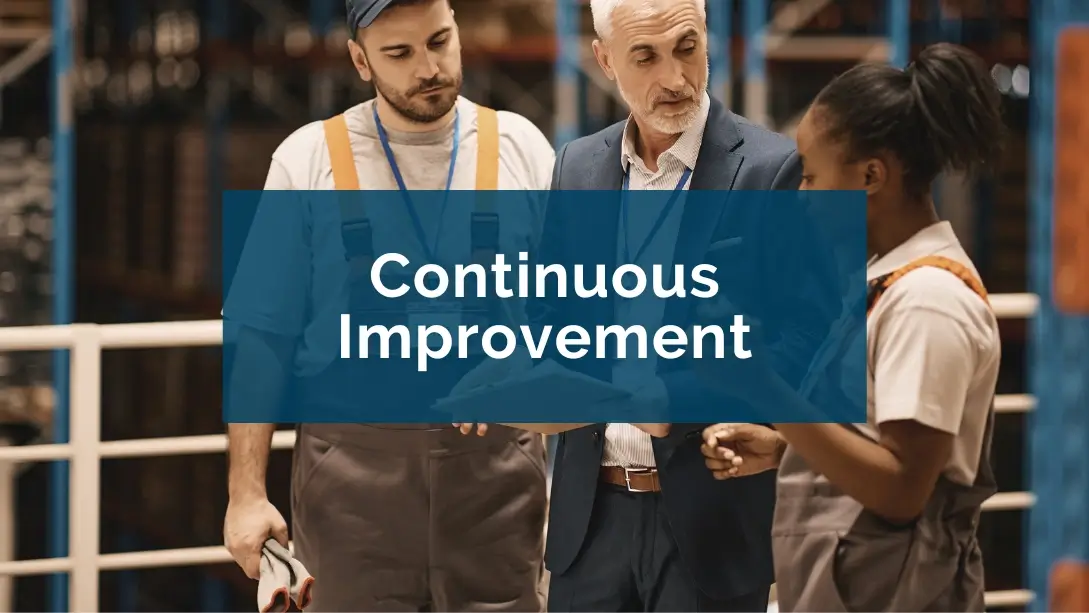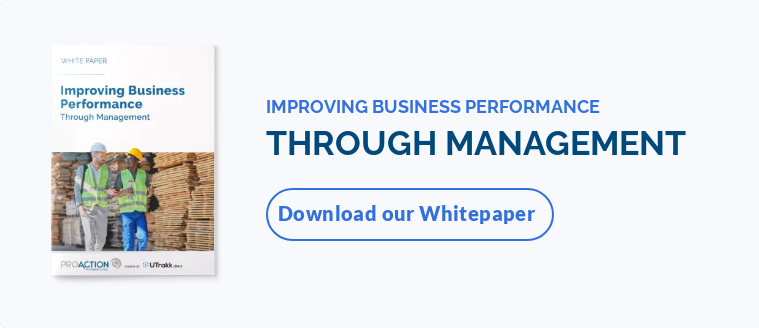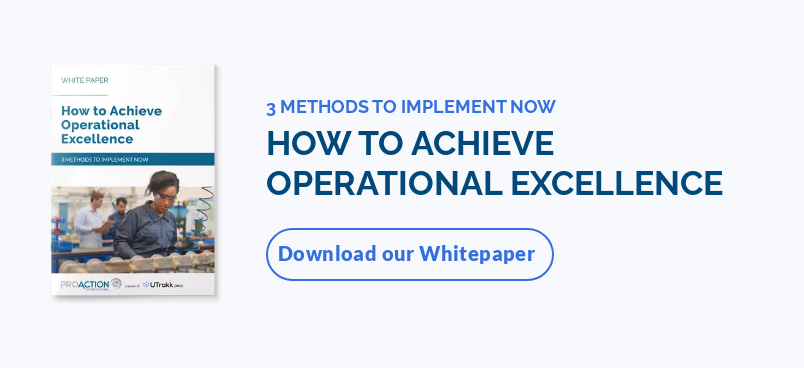The concept of continuous improvement
The concept of continuous improvement comes from the Japanese term "kaizen" ("positive change"). It refers to a progressive approach to identifying, analyzing, and implementing regular positive changes and improvements in the workplace.
A continual process improvement fosters the commitment of all those involved in the organization and encourages the constant search for best practices, increased efficiency, superior quality, and innovation. It creates an organizational culture focused on learning, adapting, and progressing to achieve higher performance.
Lean and continuous improvement: what's the difference?
Lean and continuous improvement are linked. Lean is a global management approach to eliminate waste, improve work processes and production process efficiency, and maximize customer value.
Lean provides the guiding principles
and values, while continual improvement offers the framework and methods for applying Lean. Together, they cultivate learning, collaboration, and innovation within the company, paving the way for constant and sustainable performance improvement.
The benefits of the continuous improvement process
A continual improvement process has many advantages for a company. Here are the main ones:
Increased operational efficiency
A continuous improvement strategy is one of the best ways to improve processes and operations. By identifying and eliminating malfunctions and bottlenecks and reducing waste, the company can improve productivity and cost savings and increase overall efficiency.
Improved quality
By adopting this approach, the organization can focus on better product/service quality control. That leads to greater customer satisfaction and loyalty. It also has a positive impact on the company's reputation.
Greater innovation and adaptation
Continuous improvement encourages innovation and the management of change and transition. By encouraging employees to make suggestions for improvement, the company fosters an environment conducive to innovation.
Moreover, by identifying and adapting more easily to market changes (trends, technologies, demands, Etc.), the organization can remain competitive and prepare for its future growth.
Greater employee involvement
When employees are involved in finding solutions and are encouraged to share their improvement ideas, they feel valued and invested in the company's long-term success. That leads to greater motivation, job satisfaction, and talent retention.
Competitive advantage
A company that implements a continuous improvement program enjoys a significant competitive advantage. By constantly striving for improvement, it can differentiate itself from its competitors by offering products/services better adapted to customer expectations.
Risk reduction
Continuous improvement enables potential problems to be detected and resolved quickly before they become too serious. That reduces risks to operations, finances, and reputation.
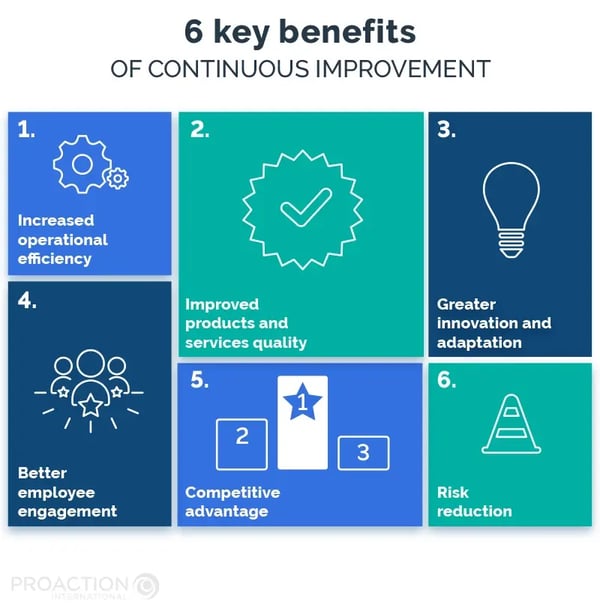
In short, continuous improvement is essential for organizations wishing to thrive and adapt in a constantly changing environment.
The main continuous improvement methods
Kaizen
This Japanese philosophy emphasizes continuous improvement at all levels of the organization. It encourages small changes and the involvement of all employees in identifying and implementing incremental improvements. Kaizen fosters learning, collaboration, and innovation.
In management, facing a problem is not considered a failure. On the contrary! Rather, it's an opportunity for improvement. From this perspective, becoming aware of an issue and finding its solution becomes learning, creating value for the whole company.
Yves LeBrasseur, Senior Expert at Proaction International.
Lean Management
Originally developed by Toyota, Lean management aims to reduce waste and maximize customer value. This method focuses on continuous process improvement, reducing lead times, optimizing workflows, and involving employees of the entire organization.
Six Sigma
The Six Sigma method aims to reduce capacity and defects in manufacturing processes. It relies on methodologies such as DMAIC (Define, Measure, Analyze, Improve, Control) to solve problems and improve performance.
The aim is to achieve a high level of total quality management by applying deviations from specifications.
The 5S
The 5S method aims to organize the work environment efficiently by focusing on five principles: Seiri (Clear), Seiton (Tidy), Seiso (Clean), Seiketsu (Standardize), and Shitsuke (Maintain).
It helps to continuously improve efficiency, safety, and quality by eliminating clutter, making it easier to find information, and enabling a well-ordered working environment.
Each of these methods can be adapted to suit the specific needs and objectives of the company.
PDCA cycle: the 4 key stages of the continuous improvement model
Also known as the Deming cycle, the PDCA (Plan-Do-Check-Act) is an iterative method of continuous improvement. It breaks down into four distinct stages:
1) Plan
In this first stage, the company identifies a specific problem or opportunity for improvement. The main goal of this planning phase is to set clear objectives and to determine the actions needed to achieve them. That involves collecting relevant data, analyzing the current processes, defining success criteria, and drawing up a detailed action plan.
2) Do
Once the action plan has been drawn up, it's time to implement it. This stage is about carrying out the activities completed and implementing the changes or improvements identified on a small scale. It is important to ensure that the plan is properly implemented.
3) Check
That involves measuring and evaluating the results achieved against the objectives defined in the first stage. The company compares actual data with expected data. It analyzes deviations and the effectiveness of actions taken. This evaluation enables strengths, weaknesses, and improvement opportunities to be identified.
4) Act review and evaluate
The final step of the Deming Wheel is to act on the evaluation results. The company adjusts and corrects the continuous improvement processes based on the conclusions drawn. That may involve modifying the initial plan, implementing new actions, solving problems, or adjusting to optimize results.
Once this stage has been completed, the Plan-Do-Check-Act cycle starts again, enabling a continuous improvement loop.
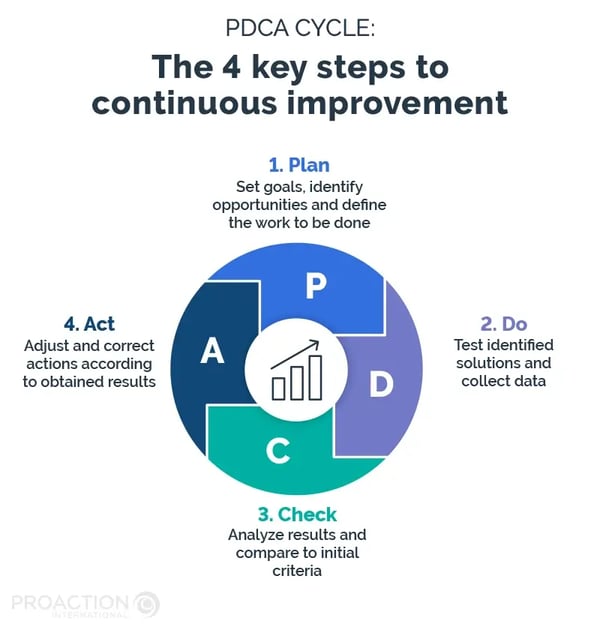
As you can see, this is an ongoing process. Each cycle contributes to continuous progress and small improvements that accumulate over time.
Tips for implementing a continuous improvement approach
Have a clear vision and measurable objectives.
A clear vision is essential among the key elements to implementing a continuous improvement culture. You must set measurable and engaging objectives aligning with the company's mission and values. Also, define an effective strategy for achieving these objectives.
Encourage employees at all levels to participate.
To create a culture of continuous improvement, it's crucial to encourage the participation and commitment of all employees.
Remove barriers between different levels of the organization. Create a climate of trust conducive to communication and openness, where every employee feels valued and encouraged to take the initiatives to bring their knowledge and innovative ideas.
Involve employees at all company levels by organizing training courses, brainstorming workshops, and experience-sharing sessions. Reward efforts and suggestions for improvement to boost motivation and commitment.
Leadership plays an essential role here, as each manager is responsible for motivating and supporting the people they manage so that together they can contribute to the company's continuous improvement.
In a continuous improvement approach, one of the managers' priorities is reinforcing this discipline among all employees. Everyone has been working towards the same goal by communicating common and individual objectives.
Yves LeBrasseur, Senior Expert at Proaction International.
Use the right tools.
A culture of continuous improvement also means using the right tools and resources. Ensure you provide employees with what they need to move in this direction. Identify the problem-solving techniques and process analysis methods relevant to your business. Make sure they are accessible to all employees.
Practice benevolent communication, show empathy, and give constant feedback to your teams. Also, offer training and coaching opportunities for those who wish to deepen their continuous improvement skills.
Training and, above all, team coaching is essential. To be successful in any business, repetition and coaching are key factors. The organization will therefore need people who know and master the methodology to guide employees constructively.
Yves LeBrasseur, Senior Expert at Proaction International.
Evaluate progress and adjust strategy.
Monitoring and evaluation are key to measuring progress in implementing continuous improvement. Regularly analyze results and trends to identify opportunities for improvement. Adjust your strategy in line with these results, making any necessary modifications.
Identify the main challenges and obstacles.
Implementing a culture of continuous improvement also means facing various challenges and obstacles. That's why it's important to anticipate them so you can better overcome them. Identify potential problem areas, such as resistance to change or lack of resources, and develop improvement strategies to resolve them.
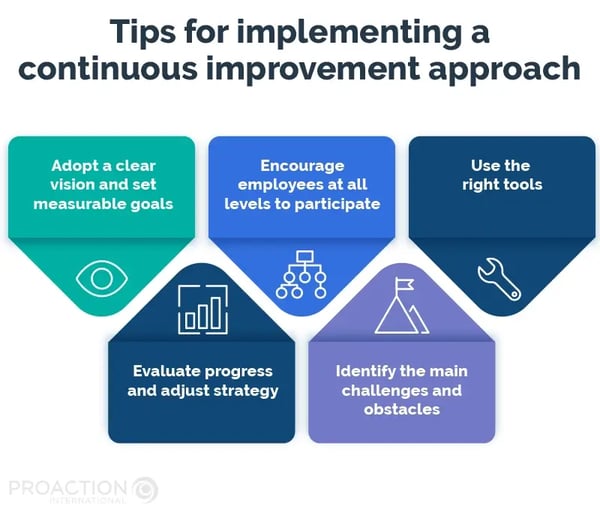
Continuous improvement tools
Earlier, we talked about using the right tools. In the context of continuous improvement, some are particularly relevant:
- The Pareto principle is a model used to identify problems and rank them in order of importance. This tool is handy for making better strategic decisions.
- The Ishikawa diagram helps identify the causes of a problem by classifying them (people, methods, materials, environment, machines). It enables visualization of the relationships between root cause and effect so that issues can be resolved systematically.
- Value Stream Mapping analyzes process steps, identifying value-added and non-value-added activities. It helps optimize workflows, reduce lead times, and eliminate waste by focusing on customer-perceived value.
- The Kanban method maintains a regular flow of goods throughout the factory and between suppliers and customers. That is achieved using cards to trigger replenishment when additional products are required automatically.
- Active Supervision Tours are inspired by the Gemba Walk, to which they add the human factor as a performance driver. They mobilize employees and deliver lasting improvements by promoting collaboration and real-time problem-solving.
UTrakk, the most comprehensive solution for management and continuous improvement
UTrakk is a daily management system designed for Industry 4.0 and 5.0, enabling the digitization of management. By guiding managers step by step in their role, this multi-platform tool gives them an overview of priorities, activities, and actions, as well as management and performance data.
Thanks to its numerous functionalities (task and priority planning, Gemba walks, customizable dashboards, real-time performance monitoring, Etc.), it offers a rapid overview of essential metrics and predictive analyses. In this way, UTrakk makes it possible to monitor, analyze and optimize key processes throughout the organization, thus actively participating in continuous improvement.
Among the many benefits of UTrakk as a DMS:
- Improved efficiency.
- Higher employee engagement.
- Enhanced performance.
- Easy measurement of key performance indicators and key behavioral indicators.
Boost your performance and stay competitive through continuous improvement.
Creating a culture of continuous improvement is a fundamental process for companies that aspire to achieve operational excellence, remain competitive, and adapt to market changes.
By understanding the principles of this approach, having a clear vision, encouraging employee participation, and providing them with the right tools, leaders can develop a workspace where improvement is widely valued, even becoming an integral part of everyday life.
Continuing improvement drives innovation and your company's long-term growth by overcoming challenges and adjusting strategy based on results.




